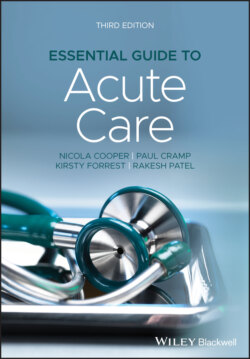Читать книгу Essential Guide to Acute Care - Nicola Cooper - Страница 21
Box 1.2 Markers of Severe Illness
ОглавлениеPhysiological
Signs of sympathetic activation e.g. tachycardia, hypertension, pale, shut down
Signs of hypoperfusion (see Chapter 5)
Signs of organ failure (see Chapter 6)
Biochemical
Metabolic (lactic) acidosis
High or low white cell count
Low platelet count
High creatinine
High C‐reactive protein (CRP)
The most common abnormalities before cardiac arrest are hypoxaemia with an increased respiratory rate and hypotension leading to hypoperfusion with an accompanying metabolic acidosis and tissue hypoxia. If this is left untreated, a downward physiological spiral ensues. With time, these abnormalities may become resistant to treatment with fluids and drugs. Therefore, early action is vital. The following chapters teach the theory behind ABCDE in more detail. Practical courses also exist which use scenario‐based teaching on how to manage patients at risk (see further resources). These are recommended because the ABCDE approach described below requires practical skills (e.g. assessment and management of the airway) which cannot be learned adequately from a book.
ABCDE is the initial approach to any patient who is acutely ill:
A – assess airway and treat if needed
B – assess breathing and treat if needed
C – assess circulation and treat if needed
D – assess disability and treat if needed
E – expose and examine patient fully once A, B, C, and D are stable. Further information gathering and tests can be done at this stage
Do not move on without treating an abnormality. For example, there is no point in doing an arterial blood gas on a patient with an airway obstruction
A more detailed version of the ABCDE system is shown in Box 1.3.
